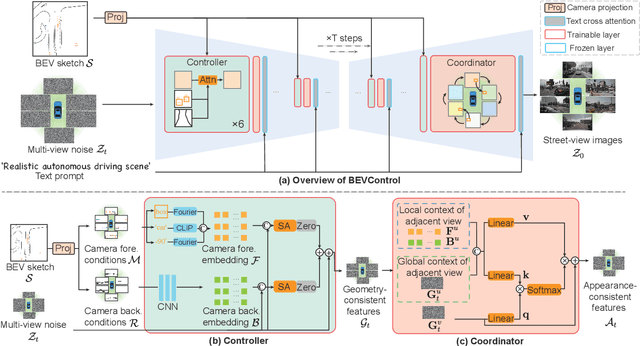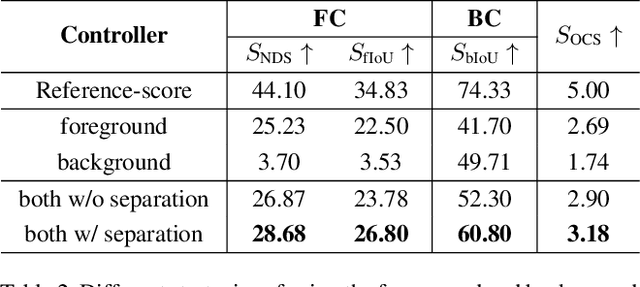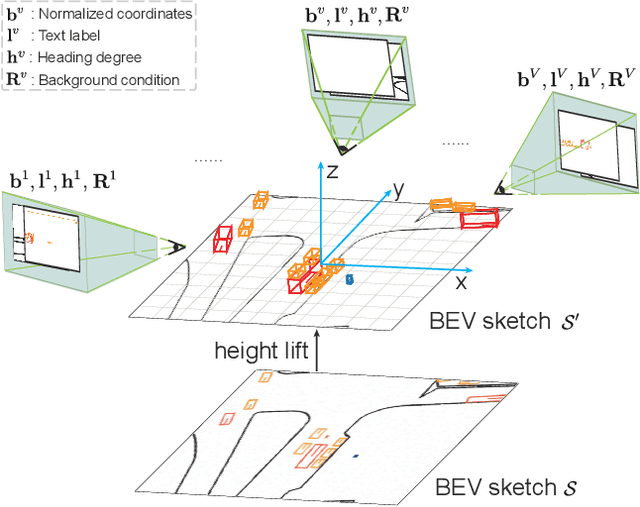Enhui Ma
Tianjin University
MiLA: Multi-view Intensive-fidelity Long-term Video Generation World Model for Autonomous Driving
Mar 20, 2025Abstract:In recent years, data-driven techniques have greatly advanced autonomous driving systems, but the need for rare and diverse training data remains a challenge, requiring significant investment in equipment and labor. World models, which predict and generate future environmental states, offer a promising solution by synthesizing annotated video data for training. However, existing methods struggle to generate long, consistent videos without accumulating errors, especially in dynamic scenes. To address this, we propose MiLA, a novel framework for generating high-fidelity, long-duration videos up to one minute. MiLA utilizes a Coarse-to-Re(fine) approach to both stabilize video generation and correct distortion of dynamic objects. Additionally, we introduce a Temporal Progressive Denoising Scheduler and Joint Denoising and Correcting Flow modules to improve the quality of generated videos. Extensive experiments on the nuScenes dataset show that MiLA achieves state-of-the-art performance in video generation quality. For more information, visit the project website: https://github.com/xiaomi-mlab/mila.github.io.
DiVE: DiT-based Video Generation with Enhanced Control
Sep 03, 2024



Abstract:Generating high-fidelity, temporally consistent videos in autonomous driving scenarios faces a significant challenge, e.g. problematic maneuvers in corner cases. Despite recent video generation works are proposed to tackcle the mentioned problem, i.e. models built on top of Diffusion Transformers (DiT), works are still missing which are targeted on exploring the potential for multi-view videos generation scenarios. Noticeably, we propose the first DiT-based framework specifically designed for generating temporally and multi-view consistent videos which precisely match the given bird's-eye view layouts control. Specifically, the proposed framework leverages a parameter-free spatial view-inflated attention mechanism to guarantee the cross-view consistency, where joint cross-attention modules and ControlNet-Transformer are integrated to further improve the precision of control. To demonstrate our advantages, we extensively investigate the qualitative comparisons on nuScenes dataset, particularly in some most challenging corner cases. In summary, the effectiveness of our proposed method in producing long, controllable, and highly consistent videos under difficult conditions is proven to be effective.
Unleashing Generalization of End-to-End Autonomous Driving with Controllable Long Video Generation
Jun 03, 2024Abstract:Using generative models to synthesize new data has become a de-facto standard in autonomous driving to address the data scarcity issue. Though existing approaches are able to boost perception models, we discover that these approaches fail to improve the performance of planning of end-to-end autonomous driving models as the generated videos are usually less than 8 frames and the spatial and temporal inconsistencies are not negligible. To this end, we propose Delphi, a novel diffusion-based long video generation method with a shared noise modeling mechanism across the multi-views to increase spatial consistency, and a feature-aligned module to achieves both precise controllability and temporal consistency. Our method can generate up to 40 frames of video without loss of consistency which is about 5 times longer compared with state-of-the-art methods. Instead of randomly generating new data, we further design a sampling policy to let Delphi generate new data that are similar to those failure cases to improve the sample efficiency. This is achieved by building a failure-case driven framework with the help of pre-trained visual language models. Our extensive experiment demonstrates that our Delphi generates a higher quality of long videos surpassing previous state-of-the-art methods. Consequentially, with only generating 4% of the training dataset size, our framework is able to go beyond perception and prediction tasks, for the first time to the best of our knowledge, boost the planning performance of the end-to-end autonomous driving model by a margin of 25%.
BEVControl: Accurately Controlling Street-view Elements with Multi-perspective Consistency via BEV Sketch Layout
Aug 07, 2023



Abstract:Using synthesized images to boost the performance of perception models is a long-standing research challenge in computer vision. It becomes more eminent in visual-centric autonomous driving systems with multi-view cameras as some long-tail scenarios can never be collected. Guided by the BEV segmentation layouts, the existing generative networks seem to synthesize photo-realistic street-view images when evaluated solely on scene-level metrics. However, once zoom-in, they usually fail to produce accurate foreground and background details such as heading. To this end, we propose a two-stage generative method, dubbed BEVControl, that can generate accurate foreground and background contents. In contrast to segmentation-like input, it also supports sketch style input, which is more flexible for humans to edit. In addition, we propose a comprehensive multi-level evaluation protocol to fairly compare the quality of the generated scene, foreground object, and background geometry. Our extensive experiments show that our BEVControl surpasses the state-of-the-art method, BEVGen, by a significant margin, from 5.89 to 26.80 on foreground segmentation mIoU. In addition, we show that using images generated by BEVControl to train the downstream perception model, it achieves on average 1.29 improvement in NDS score.
CVSformer: Cross-View Synthesis Transformer for Semantic Scene Completion
Jul 16, 2023Abstract:Semantic scene completion (SSC) requires an accurate understanding of the geometric and semantic relationships between the objects in the 3D scene for reasoning the occluded objects. The popular SSC methods voxelize the 3D objects, allowing the deep 3D convolutional network (3D CNN) to learn the object relationships from the complex scenes. However, the current networks lack the controllable kernels to model the object relationship across multiple views, where appropriate views provide the relevant information for suggesting the existence of the occluded objects. In this paper, we propose Cross-View Synthesis Transformer (CVSformer), which consists of Multi-View Feature Synthesis and Cross-View Transformer for learning cross-view object relationships. In the multi-view feature synthesis, we use a set of 3D convolutional kernels rotated differently to compute the multi-view features for each voxel. In the cross-view transformer, we employ the cross-view fusion to comprehensively learn the cross-view relationships, which form useful information for enhancing the features of individual views. We use the enhanced features to predict the geometric occupancies and semantic labels of all voxels. We evaluate CVSformer on public datasets, where CVSformer yields state-of-the-art results.
 Add to Chrome
Add to Chrome Add to Firefox
Add to Firefox Add to Edge
Add to Edge